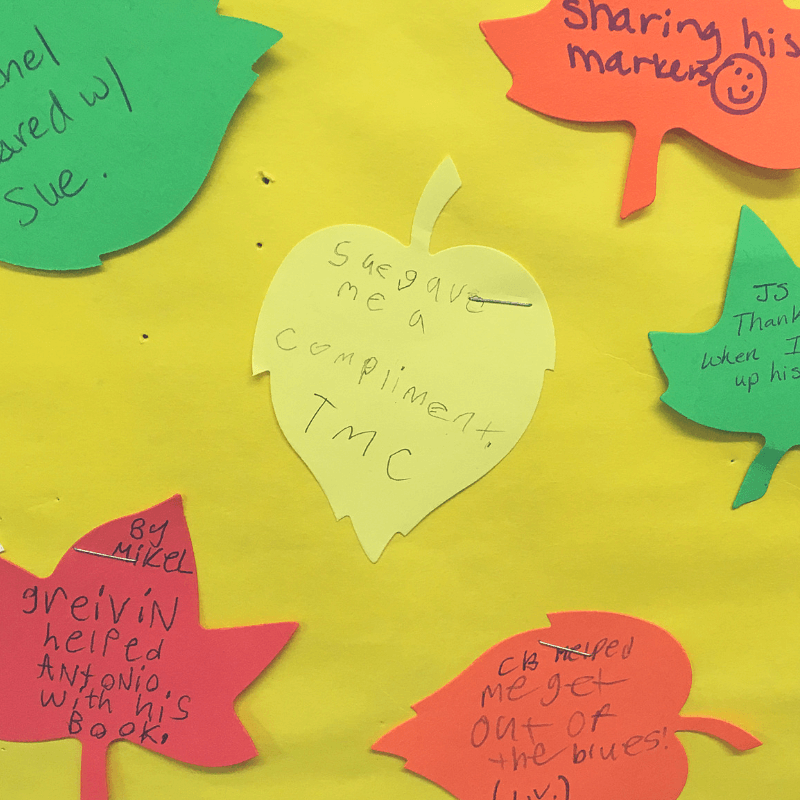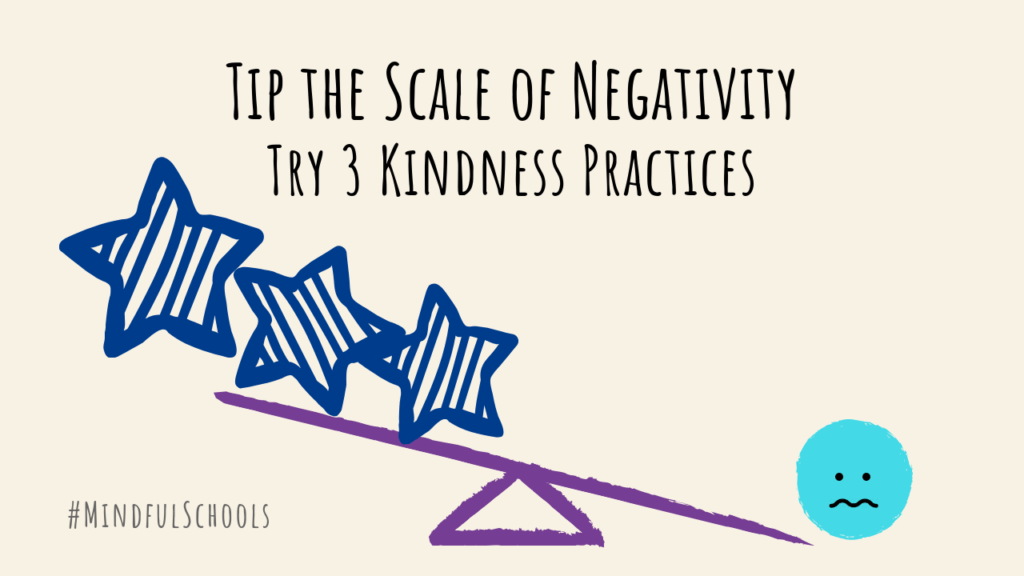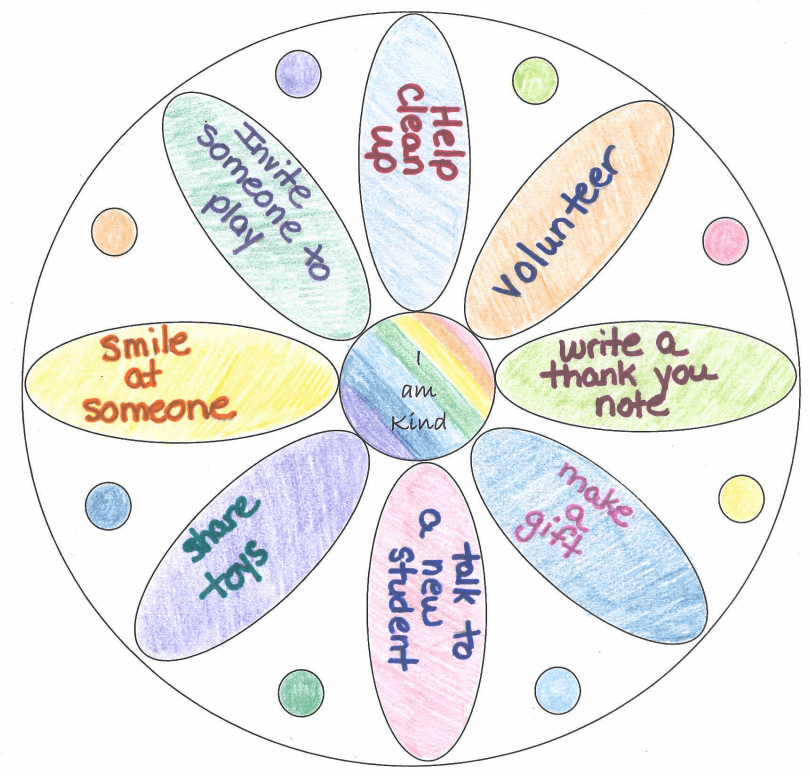“There’s so much negativity–they’re always tattling and calling each other out. How can we change this? I am open to ideas!” This was a recent plea from a 4th and 5th grade teacher.
As a part of the educational team at a therapeutic school, I’m often called on to consult or provide direct intervention in the areas of self-awareness, self-regulation, and social emotional learning. We serve students who live with mental health diagnoses, have behavioral challenges, and often come to us with a history of trauma. As such, social emotional learning is often the area where they need the most support. Mindfulness instruction, yoga classes, and psychosocial skills curricula are an integral part of our school day.
When I work with our teachers and students, I will often introduce Kindness exercises to help address the “negativity”–you can find three exercises below. But first, let’s discuss the science of why and how we experience and remember “the negative.”
Why So Much Negativity?
As psychologist Rick Hanson notes, evolution has primed our brain, and specifically the amygdala, to have a negativity bias. At one time this bias was necessary for survival. The amygdala is the brain’s alarm center, with strong connections to our emotions and memories. The amygdala uses about about ⅔ of its neurons to watch for negative experiences and once found, these experiences are stored quickly. For children and teens who have had adverse experiences growing up, the amygdala can be even more sensitive and reactive. For then, the amygdala is like a smoke detector that is placed directly over a cooking surface, making alarm bells go off at the slightest hint of perceived danger.
“The alarm bell of your brain — the amygdala — uses about two-thirds of its neurons to look for bad news: it’s primed to go negative.” – Rick Hanson
Positive memories and experiences, on the other hand, are much slower to store, often have less intense body sensations, and need more repetition to “stick.”
Promoting Kindness through 3 Mindful Activities
In order to provide opportunities to notice, practice, and spread kindness within our school, we host a month-long Kindness Challenge.
Our goal is to promote acts of kindness in the classrooms and school-wide and for teachers and students to experience the embodied benefits of sharing acts of kindness as noted in some of the studies cited here. Acts of kindness can benefit the person sharing kindness, the recipients, and also anyone who witnesses these acts. In our mindfulness classes, we talk about how experiencing kindness can feel in the body. Being connected to and aware of how our body feels during positive experiences is an important part of moving our brain’s bias from negative to positive. We speak about how kindness is like the reverse of bullying.
Our Kindness Challenge has three main areas of focus: noticing acts of kindness, performing acts of kindness, and being kind to ourselves.

Begin the month-long Kindness Challenge by brainstorming what kindness might look like in school. You can start by reading the book What Does It Mean To Be Kind? by Rana DiOrio for ideas. Then, give each class a bag of colorful paper leaf cutouts. Tell students that each time they see someone do something kind for a person or the school environment, they can write the act of kindness on the leaf. The challenge is to see how many leaves the class can collect.
At our school, this activity started off slowly, as many students were not used to “looking for the good.” However, with modeling by staff, students soon became excellent kindness detectives and we collected over 100 leaves by the end of the challenge. Students also reported sharing this activity at home.
2) “I Am Kind” Flowers
Begin this lesson with a guided mindfulness practice to notice what it might feel like to give and receive kindness. You can read the book How Full Is Your Bucket? by Tom Rath to illustrate how acts of kindness can “fill the bucket” of the giver and the recipient. Then take the brainstorming ideas from the Kindness Leaves activity and let students select their favorites to create “I Am Kind” flowers. Students set an intention to practice these acts of kindness during the challenge.
3) “Self-Kindness” Beads
As part of our focus on kindness, we talk about the importance of being kind to ourselves. Students share how, when they are having a difficult time, it is much harder for them to be kind to others. Discuss ideas of how we can be kind to ourselves and what things make us feel better. With this list, introduce a kindness bead activity. Each bead signifies an act of kindness students can do for themselves. Invite students to add beads to their kindness bead string that reminds them to care for themselves. These beads can be hung on water bottles, belt loops, or backpacks.
Kindness is a Practice
Our Kindness Challenge ran for a full month. Some of these activities were done specifically in mindfulness class and others were taken into the classroom for collaborative work. Throughout the Challenge, I witnessed many occasions where students and staff went out of their way to be kind and to notice heartful acts done by others.
As with any new habit, this Kindness Lens takes practice, reminders, modeling and celebrations of success. We frequently revisit Kindness in mindfulness class. Students are encouraged to continue to notice and share kindness throughout the school day with staff and peers. We celebrate and notice how it feels to be kind and to see kindness in action.
The negativity bias is part of our human evolution, but every day we have the chance to change this, one heartful act at a time.
As for the teacher who was feeling overwhelmed by the negativity–she herself has been able to take a moment to notice “what went right today,” even amid the daily challenges of teaching. This Kindness practice has become an integral part of our school culture–our teachers, staff, and students continue to notice and perform acts of kindness. I’ve seen this shift in our school culture support peace, respect and learning.
Gloria Sanford-Breton, OTR/L, RYT, RCYT is an occupational therapist who has worked with adults and children for over 30 years. She has trained with Mindful Schools, ChildLight Yoga, YogaNH to bring mindfulness, yoga, and a more holistic approach to her OT practice. Gloria offers specialized presentations on bringing trauma-informed mindfulness and yoga to youth, staff, and caregivers. She currently works in a therapeutic education program in Massachusetts, where she specializes in trauma-informed interventions, self-regulation, and manages the mindfulness and yoga program.


